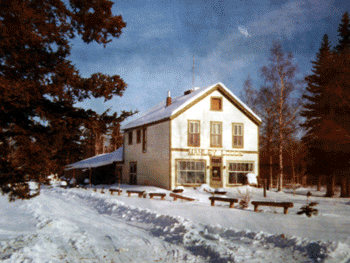
ROADHOUSE HISTORY

In 1903, Sam's Rooms and Meals, now called the Manley Roadhouse, opened in the community. It was originally built on the north side of the slough and later moved to its current location on the south side. The Roadhouse served as a resting and meeting place for riverboat crews, miners and travelers who came via dog team. It was even a stopping point for the 1925 historic serum run to save Nome. A relay of dog teams carried diphtheria anti-toxin to halt the deadly diphtheria epidemic for the 675 miles in temperatures of -60 F and colder.
"MANLEY ROADHOUSE, SERVING HOSPITALITY SINCE 1903"

by Ray Bonnell
FAIRBANKS — John Karshner was prospecting for gold when he stumbled across a hot springs in the hills just north of a small Tanana River tributary in 1902. Karshner had a farming background and saw more potential for profit in selling food to prospectors and miners than in actually mining, so he immediately staked out a homestead north of the stream, which became known as “Hot Springs Slough.”
A trading post supplying goods to prospectors in the Tofty and Eureka areas to the north was located about 10 miles to the east, at the confluence of Baker Creek and the Tanana River. However, seeing the advantages of the hot springs site, entrepreneurs soon built a general store on the north side of Hot Springs Slough, eclipsing the Baker Creek operation. The Baker Creek site was located along the route of the Washington-Alaska Military Cable and Telegraph System (WAMCATS) telegraph line and survived for a time as a telegraph station, but except for a small sawmill, otherwise passed into obscurity.
Hot Springs (also called Baker Hot Springs and eventually Manley Hot Springs) was in the ascendant though, and other facilities sprouted up. According to the Manley Roadhouse website, in addition to the store, Sam’s Meals and Rooms (which eventually became the Manley Roadhouse) opened in 1903, also on the north side of the slough.
Most of the new town’s businesses appear to have been clustered along the base of the hills on the north bank of the slough, rather than on the flatter ground to the south. This was in part because of the Martin Sabin homestead, which occupied about 150 acres on the south side of the slough where the town airport is now. I think it was also because of a military withdrawal on slough’s south bank made to support the WAMCATS telegraph line. When the landlines were replaced by wireless telegraphy (radio) most of the telegraph stations closed. Consequently, the military withdrawal at Hot Springs was abandoned, and business began moving across the slough.
In a biography of Stanley Dayo, a long-time Manley resident, he states that the Manley Roadhouse was moved across the slough to its present location in 1925. Late January and early February of 1925 was also when the serum run from Nenana to Nome occurred, during which 20 mushers relayed diphtheria anti-toxin to combat an outbreak of the deadly disease.
The book, “The Cruelest Miles: The Heroic Story of Dogs and Men in a Race Against an Epidemic,” relates the story of Edgar Kalland, an Athabascan musher who carried the serum from Tolovana to Manley, a distance of 32 miles. The temperature during his run was about 55 degrees below zero (F) and one newspaper article reported that upon arriving at the Manley roadhouse, Kalland’s mittens were frozen to the sled’s handle bar. The roadhouse proprietor reportedly poured boiling water over the handle bar to free Kalland’s mittens. (I’m assuming the roadhouse had not been moved before the serum run took place.)
The roadhouse has gone through a succession of owners, but it basic appearance has changed little over the years. The front portion of the establishment, a 2-½ story wood-frame structure with a gable roof, looks pretty much the same as it did when moved across the slough. It is very typical of commercial buildings built during the early 1900s.
The rear section of the building has changed gradually during the years — morphing from a small one-story addition (with additional additions tacked on, Alaska-style) to the present two-story structure. The roadhouse is still operating, serving Alaskan hospitality to locals and visitors year-round.
